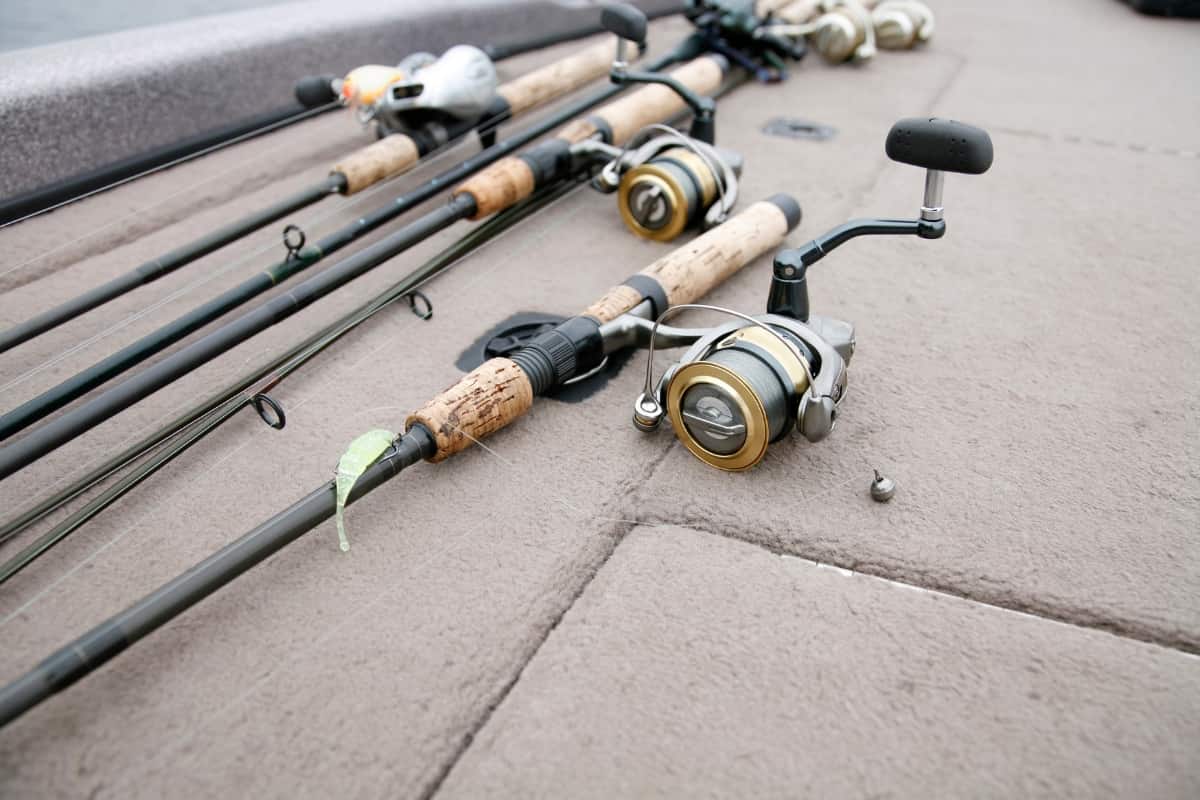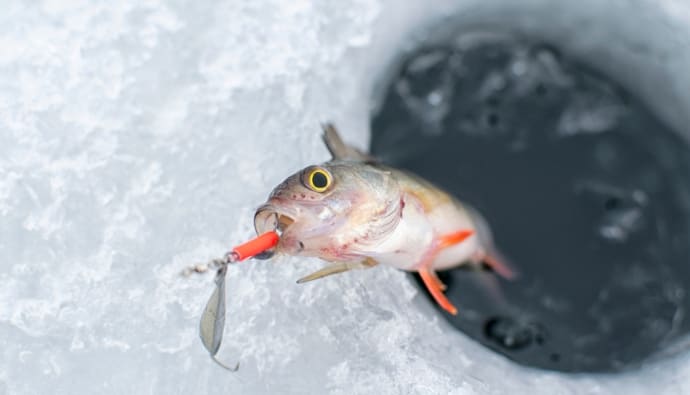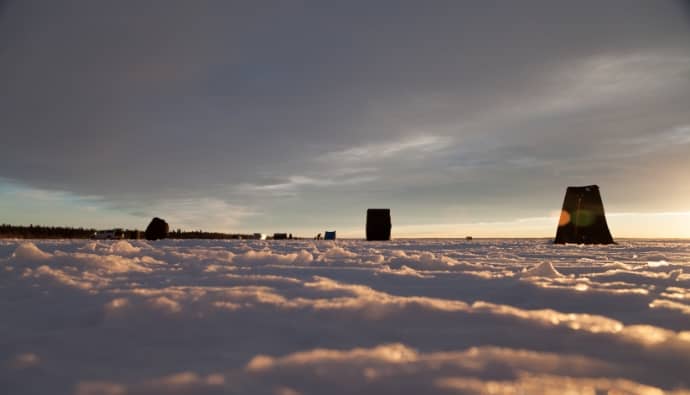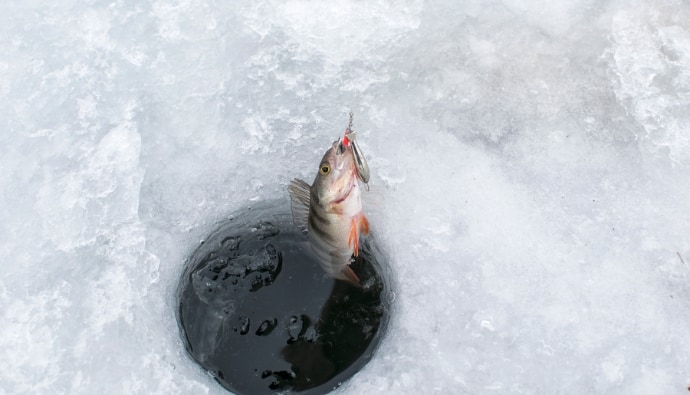Crappie are a popular target for ice fishing enthusiasts due to their continued activity even in frozen waters. When planning your next crappie ice fishing trip, there are several factors to consider. Start by choosing a location with a high crappie population, such as the Neosho River or Lake of the Woods. To ensure a successful outing, dress warmly and bring the necessary fishing equipment, including a fishing rod, ice auger, jigs, minnows, and small tubes. Experiment with various lures and baits to maximize your catch. Drilling multiple holes can also improve your chances of landing crappie. Before heading out, make sure to verify the ice thickness and review local weather conditions for a safe and enjoyable fishing experience.
The most common crappie species include the white crappie and the black crappie. Most ice fishermen use their difference in the number of spines to distinguish them. Black crappie has seven to eight spines on their dorsal fin, while white crappie has six spines.
If you’re planning to go ice fishing for crappie, here is a complete guide to help you identify the best fishing spots and techniques you can use to have a rewarding experience.
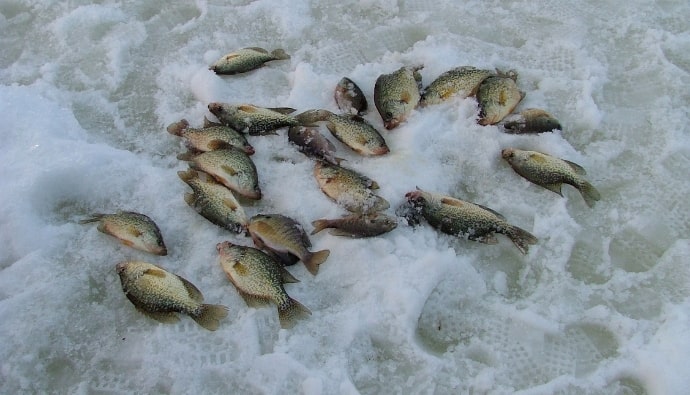
Best Places for Crappie Ice Fishing
Numerous water bodies in the US act as a home to different fish species. Here are the best ice fishing spots for crappies
1. Lake of the Woods, Oregon
Lake of the Woods is a popular ice fishing spot in Klamath County. This lake is home to many species, including trout, salmon, and crappie.
The perfect place to find crappie in this lake is in deep basin areas or mid-depth flats. Also, you can spot them around structures such as islands, at the base of drop-offs, and humps.
2. Neosho River, Oklahoma
Neosho river is located in Oklahoma and is home to thousands of black and white crappie. Fishing here is dictated by the current, and you can find crappies in current breaks, laydowns, brush piles, and slack water eddies.
On a good day, you can catch a good-sized crappie that can suspend up to 30 feet.
3. Reelfoot Lake, Tennessee
This is one of the best crappie destinations in Tennessee. Reelfoot Lake has plenty of lily pads, stump fields, and vegetation that serves as crappie feeding grounds. This lake is a good option for anglers who target fishing in shallow areas.
4. Clear Lake, California
Although this lake is a popular destination for bass fishing, it also boasts excellent crappie fishing opportunities. Crappies here can weigh as much as 4 pounds, and you can locate them in shallow covers like weed lines, docks, and brush piles.
Equipment and Gear
When ice fishing for crappie, ensure you use the right equipment and gear. Here is what you should bring along when targeting crappie.
- Ice Auger: You can only catch fish during winter if you dig an ice hole. Ensure your auger is high quality and sharp enough to dig deep holes in the ice.
- Fishing rods and reels: Invest in a tailored tackle because you can use it to catch multiple fish species.
- FishFinder: Finding crappie can be pretty hectic, and a FishFinder will help you locate where they are.
- Warm clothes: It’s pretty cold during winter, and it’s advisable to wear warm clothes to protect yourself from getting sick.
Other necessary fishing gear and equipment include a plastic bucket, an ice shanty, emergency ice picks, a propane heater, a face mask, sunglasses, and an ice scoop.
Best Bait and Lure for Crappie
The cold water makes the crappie’s metabolism slow down. The best way to attract them is by slowly presenting a lure to the water column. Crappies love feeding on live bait. Mash a few worms into a paste and then drop them into water.
The scent from the ice fishing bait will attract crappie towards your trap. Other lures to use when hunting for crappie include:
- Marabou Jigs
- Tube Jigs
- Fuzzy Grubs
- Stinger Tail Minnows
- Micro Swimbaits
- Jigging Spoons
- Suspending Jerkbaits
Tips and Techniques for Catching Crappie
Fishing for crappie can be unpredictable. Sometimes, you’ll locate their schools quickly, while it will be impossible to catch even a single crappie in some days.
Here are the best tips you can follow to increase the chances of catching crappie.
Look for the Entire Water Column
Instead of targeting a single spot, ensure you fish the whole water column. Use slowly swimming baits like live minnows to attract crappie instead of using dive-bombing lures.
Fish at Night
Crappies are active and aggressive at night. They move from deep water to weed lines and shallow areas in search of food. Ensure you use night lures and baits.
Balance Your Jigging Combo
During mid-winter, the cold weather makes these creatures a bit weary, and you can hardly detect their light bites. Ensure you use an ultra-light line and a rod with a spring bobber to add sensitivity.
Use Different Fishing Lures and Baits
The crappie can be more selective and not bite your regular bait. Increase your chances of catching them by using larger baits like plastic baits, spoons, and swimbaits. This technique will also sift the smaller crappies from the bigger ones.
Try Using the Dead Stick Fishing Technique
If you spend some time jigging and fail to induce a bite, it’s time to change the approach. Place a minnow-tipped ice jig rigged on a hook and place it below your hook. Ensure the bait is in the strike zone to trigger bites.
Conclusion
Crappies are among the most sought fish during winter because they remain active even when the water has frozen. The most popular lakes and rivers you can go fishing for crappie include the Neosho River, the Lake of the Woods, Reelfoot Lake, and Clear Lake.
To ensure you have the best fishing experience, ensure you have the right equipment and gear. Also, ensure you carry bait and lure specifically made for crappie fishing. The most popular lures include Marabou Jigs, Tube Jigs, Fuzzy Grub, Stinger Tail Minnows, and Jigging Spoons.
Remember, crappie species are pretty active at night, and you should go fishing at this time to increase your chances of catching one. Other tactics to attract them include using the dead stick technique, balancing your jigging combo, and using different baits and lures.
Always prioritize your safety by checking ice thickness and the weather around your fishing spot to prevent accidents.




 Facebook
Facebook YouTube
YouTube